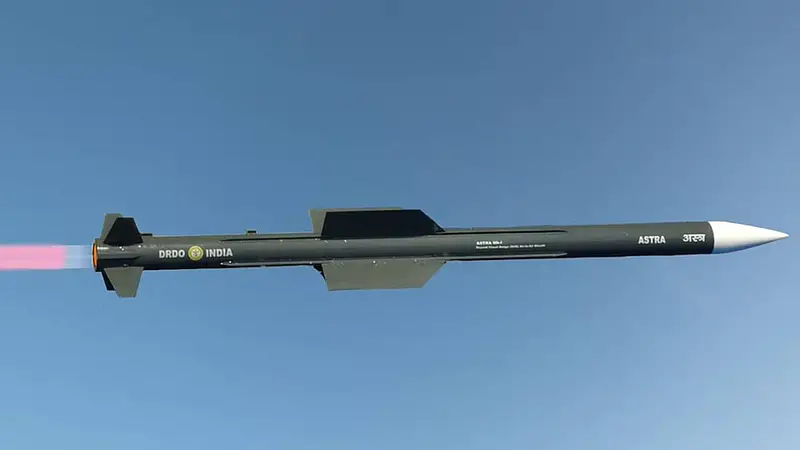India recently test-fired its homegrown Astra Beyond Visual Range Air-to-Air (BVRAAM) missile from its indigenous Tejas LCA fighter jet.
This achievement catapults India into an exclusive league of nations with the capability to develop and launch their indigenous air-to-air missile from fighter aircraft developed on home turf.
Following a similar trajectory, Japan appears to be planning to design a new air-to-air missile intended for the next-generation fighter aircraft being co-developed with Britain and Italy.
The development of the missile is anticipated to be completed by 2035, aligning with the scheduled deployment of the first aircraft linked to the joint project in the same year, according to Japanese media outlets.
The inception of the joint fighter jet initiative was announced in December 2022 by the leaders of Japan, the UK, and Italy.

Collaborative efforts among companies from the UK, Japan, and Italy are underway within the Global Combat Air Program (GCAP), where they jointly build a new fighter jet alongside other systems like drones. The overarching objective of this program is to introduce the aircraft by 2035.
A joint study conducted by Japan and Britain to discern the ideal attributes for the new fighter jets intended for deployment by Japan’s Air Self-Defense Force has indicated that an indigenously developed air-to-air missile would not only exhibit superior performance but also entail lower costs in comparison to the European-developed air-to-air Meteor missile, Kyodo News reported.
However, in the future, Japan might contemplate incorporating missiles employed by British and Italian warplanes, thus enhancing overall capabilities.
The Meteor missile, a product of collaborative efforts from six European nations, including Britain and Italy, is specifically designed for utilization in Eurofighters and other aircraft. It is poised to emerge as a plausible candidate for integration into both countries’ new sixth-generation fighter jets.
Turning to electronic components destined for the new fighters, adaptations are planned for an ASDF C-2 transport aircraft to facilitate flight testing.
Moreover, a dedicated focus on artificial intelligence research is set to foster the development of drones to augment fighter jets’ operational capacities.
Why Locally Developed Air-To-Air Missile?
Countries are revisiting their defense doctrines to embrace self-reliance in an era characterized by relentless technological progress and shifting global politics.
Japan’s endeavor to equip its upcoming indigenous fighter jets with a new homegrown air-to-air missile aligns with a trend that resonates on a global scale, as nations such as Turkey and India.
For instance, Turkey conducted several tests of its Gokdogan and Bozdogan air-to-air missiles, with intentions to eventually integrate them into their upcoming Hürjet advanced jet trainer and light attack aircraft, as well as its future fifth-generation fighter jet named KAAN.
Likewise, India has carried out multiple tests of its Astra air-to-air missile. It is likely to integrate this weapon into the Tejas fighter jet and its subsequent versions, as well as into its upcoming next-generation fighter jet, the AMCA (Advanced Medium Combat Aircraft), in the future.
Prakash Nanda, Chairman of the Editorial Board at EurAsian Times, previously highlighted: “Astra BVRAAM is designed to provide the power a modern combat aircraft needs for dominating an air space. It can be launched irrespective of the target’s relative position to the missile (and the aircraft launching it).”

The rationale for developing domestic missiles could be attributed to the benefits of functionality, performance, and cost – factors also underscored by the recent joint study conducted by Japan and the UK.
Miguel Miranda, a Philippines-based military expert, also provided insights to EurAsian Times explaining Japan’s preference for developing its air-to-air missile for their next-generation fighter aircraft instead of the Meteor missile.
He said, “Japan has been pursuing a “fifth-generation” program for a new domestic fighter jet for almost 15 years now with few tangible results. It’s an understandable challenge as these endeavors tend to be plagued by supplier issues and ballooning costs.”
Miranda explained, “Since it’s apparent that Tokyo chose a multi-partner approach through “Team Tempest,” it still needs its suite of armaments that complement the resulting fighter jet. Beyond visual range or BVR missiles are essential since.”
In addition to these considerations, Miranda pointed out that the United States cannot supply a massive number of AIM-120C missiles to Japan due to their high cost and the necessity to fulfill the demands of both domestic and international users.
Furthermore, by designing and developing its missile, Tokyo can also acquire the capability to customize the weapon’s characteristics to align with the distinct necessities of its aircraft and operational demands.
This customization facilitates improved assimilation with avionics, radar systems, and other onboard technologies, optimizing the missile’s efficiency in its designated function.
The progression towards advanced missile technology also promises to elevate Japan’s technological prowess and expertise.
This journey encompasses research and development across domains such as propulsion, guidance systems, target tracking, and stealth attributes, all collectively contributing to the broader advancement of the nation’s technology landscape.
Apart from the evident cost advantage, as using domestically developed air-to-air missiles would undeniably be more cost-effective than their European counterparts, this program will catalyze the expansion of the country’s defense industry and generate opportunities for highly skilled employment.
Meanwhile, Miranda remarked that the nature of stealth fighter programs frequently involves an element of unpredictability, making it a challenge to accurately assess Japan’s level of readiness.
Nevertheless, considering the significant territorial challenges posed by China and Russia, he emphasized that these aircraft play an indispensable role in securing and protecting Japan’s airspace.
- Contact the author at ashishmichel(at)gmail.com
- Follow EurAsian Times on Google News




